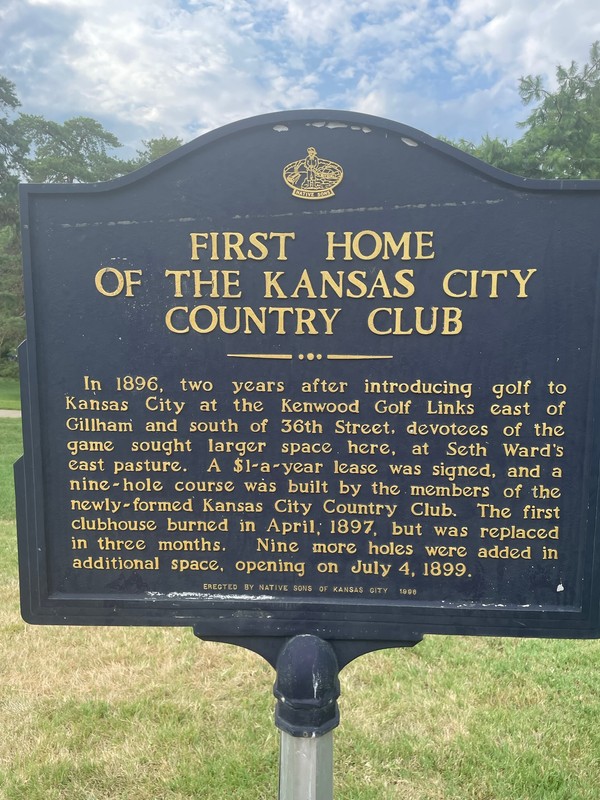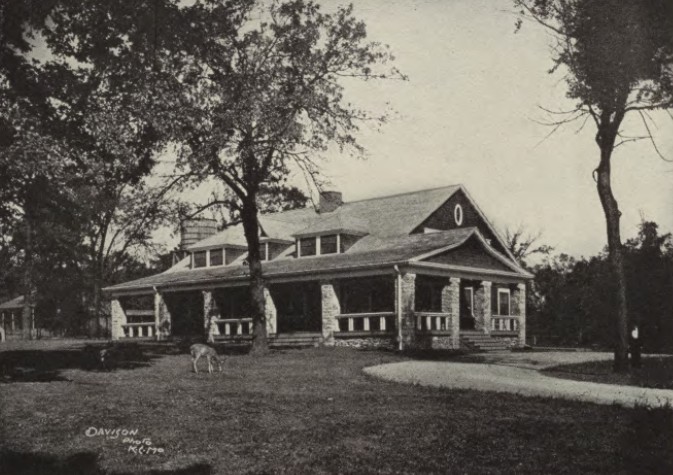First Home of the Kansas City Country Club Historical Marker
Introduction
Author-Uploaded Audio
Dr. Bill Worley shares the history of the creation of the Kansas City Country Club and its later move to the Kansas side of the metro area.
Text-to-speech Audio
This historical marker shares the history of this green space before it became one of Kansas City's most beloved public parks. In 1894, Scottish Americans in Kansas City developed the city's first golf course and club, Kenwood Golf Links. A fire in 1897 forced the members to rebuild their clubhouse within what is today's Loose Park area. After moving their course to this location, members subsequently established the Kansas City Country Club in 1898. The course and club moved again in 1926, leading to the sale of the land to Jacob Loose and the eventual donation of the property to the city for the purpose of building a park. The marker not only shares a chapter in the park's history but also commemorates the early history of golf in the Kansas City area. The establishment of the course demonstrated the rapid spread of the sport in the United States, from the first golf course in the mid-1880s to the establishment of Kansas City's first course.
Images

Clubhouse of the Kansas City Country Club

Backstory and Context
Text-to-speech Audio
It took roughly four centuries for golf to find its way from Scotland to the United States, arriving in 1888. The genesis of golf in Kansas City came a few years later in 1894 when a group of Scottish Americans built the nation's seventeenth course, a nine-hole course in the Hyde Park neighborhood called Kenwood Golf Links. The ninth hole ended in the backyard of famed architect Henry Van Brunt's home, one of the course's founders.
Unlike today's courses, the "links-style" course enjoyed little organized architecture, and maintenance on the course proved almost non-existent. The dozen or so original members did not enjoy pristine greens or sculpted fairways. On the other hand, the golfers did not have to worry about pot bunkers, either.
The clubhouse built in 1894 burned down shortly after opening, which pushed the members to build a new clubhouse and expand the course to 18 holes, notably because the course quickly grew more popular. The members purchased around 110 acres of land from Hugh Ward in what would evolve into the Country Club District. Ward agreed to lease the land to Kansas City Country Club for one dollar per year and the cost of the yearly property taxes.
W.C. Root designed the clubhouse, located near what is today the Loose Park rose garden. The clubhouse included a café and large rooms suitable for receptions, dancing, and billiards. The Kansas City Country Club formally opened in September 1898 with a tournament followed by a night of dancing. Although the course enjoyed modern, elegant touches, the course still paled in comparison to today's manicured country clubs and public golf courses. For instance, A herd of cattle often grazed on the greens. Some of the course sat on land where the 1894 Battle of Westport took place, the largest Civil War battle west of the Mississippi. Members discovered bullets, cannon balls, and pieces of rifles on the grounds.
The Kansas City Country Club remained in the same location until 1926 when its lease ended. Ward's wife concluded that the rising price of land made it too valuable to have a golf course occupy it. Thus, the Country Club moved for a third and final time. Ward sold a majority of the land to Jacob Loose, founder and owner of Sunshine Biscuits, Inc. Jacob's wife Ella donated the land to the city, who created Loose park in Jacob's honor. Meanwhile, Kansas City Country Club opened in Mission Hills, a modern and challenging golf course designed by a golf architect; a far cry from the original Kenwood Golf Links course.
Sources
Euston, Diane. "Kansas City's first country club was far from par for the course." The Telegraph (Kansas City), August 27, 2019. https://martincitytelegraph.com/2019/08/27/kansas-citys-first-country-club-was-far-from-par-for-the-course/.
Fischer, William. "First Home of the Kansas City Country Club." The Historical Marker Database. HMdb.org. December 18, 2020. https://www.hmdb.org/m.asp?m=88252.
White, George. "History of Golf - Part Five America and Golf." NBC Golf Channel. golfchannel.com. July 24, 2002. https://www.golfchannel.com/article/george-white/history-golf-part-five-america-and-golf.
Photo by David Trowbridge
Hughes' Annual Kansas City Views, Hughes Publishing, Kansas City, mo. pg
